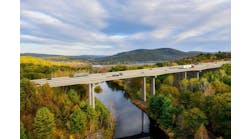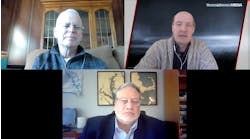During the summer of 2001, an innovative remedy was applied to a 5.5-mile section of I-40 in eastern Oklahoma. The project specified dowel bar retrofitting and overlaying an existing concrete pavement. The retrofit and overlay were not completed in two separate steps, as is most commonly done. By changing the construction methods and combining the placement of the load transfer devices along with the overlay, the contractor saved significant time and costs.
Finding faults
The project is located in Sequoyah County on I-40,
approximately 35 miles from the Arkansas border. The existing pavement
consisted of 9 in. of plain jointed concrete over 4 in. of fine aggregate base
course placed over 6 in. of fly ash treated subgrade.
Constructed in 1969, the pavement was extensively faulted
with some longitudinal cracking and shattered slabs. The designed average daily
traffic for the section was 18,200, with 28% trucks.
After a trial section was shown to be constructible and
durable, simultaneous dowel bar retrofit and bonded overlay was determined to
be a good rehabilitation technique for this section. Despite the faulting, most
of the individual slabs were in good condition. Investigation showed that loss
of aggregate interlock and stripping of the fine aggregate base was the primary
cause of faulting.
The original rehabilitation design called for the surface to
be prepared by shot blasting, slot cutting, dowel bar placement and a 4-in.
layer of concrete over the entire pavement area. The dowel bars would be 18 in.
long and 11/2 in. in diam. Three bars would be placed in each wheel path.
Two dowel bar slot options were made available in the original design, and they
could either be placed in
individual slots or three dowels per one large slot in each wheel path. Both
options are commonplace in dowel bar retrofit jobs.
Before the overlay was placed, longitudinal cracks needed to
be secured and some slabs removed and replaced.
As with any concrete design, cost is an important factor.
Method of payment for the paving was by the cu yd of concrete and by the sq yd
for placement. Additionally, since pavement edge drop-off would be limited to 4
in., traffic crossovers would not be utilized, resulting in an overall cost
savings for the project.
No shot
Preparations were made for the bonded overlay. After
approval from the Oklahoma Department of Transportation (ODOT), the contractor,
Bryan Adair Construction, Broken Arrow, Okla., used a milling machine in lieu
of shot blasting.
First, the entire surface was roughened by removing the top
1/2 in. to ensure a good bond. This was done using a CMI PR-800-7/12
milling machine (Circle 936) with a 12-ft-wide, 42-in.-diam. barrel grinder.
Milled pavement showed a roughened surface that appeared adequate to bond to
the overlay. The contractor estimated that milling was up to three times faster
than shot blasting.
After milling, the surface was swept twice using water, then
swept an additional two to three times dry.
During milling, the drum of the milling machine was lowered
an extra 4 in. at the existing joint. A 4-in.-deep trench was milled
approximately 24 in. wide, enough to accommodate the 18-in. dowel bars and the
baskets supporting them.
Crack repair and slab replacement followed. Steel was placed
to tie longitudinal cracks and, similar to large staples, these consisted of
epoxy-coated No. 4 rebar. The top is 18 in. long, and the “legs”
are 8 in. long. The “staples” were inserted into the existing
pavement 61/2 in., with 30-in. spacing.
Full-depth replacement was required for shattered
slabs, 133 panels were fully
replaced and 33 panels were partially replaced using high-early-strength
concrete.
Lowering the bars
Baskets holding 11 dowel bars in each lane were placed in
the trench and secured to the existing pavement with fasteners. The dowel bars
used were 11/4 in. in diam., the standard used in the state for new
construction. ODOT allowed this by using a no-cost change order since the
overall cross section steel surface area would be greater than the area provided
by the six in the original design.
The contractor noted that construction times for previous
jobs which used a slotting machine were slower and had high slotting machine
costs. According to the contractor, the increased productivity of using the 11
bars per lane more than offset the cost of the additional bars.
Paving was performed one lane at a time using a Gomaco CP
2600 standard concrete paver (Circle 937) to apply the 4 in. of
fiber-reinforced overlay. Compressed air was used to clean the surface steps
ahead of the paver.
After placement, the overlay surface was transversely tined
before applying a white pigment curing compound.
Daily high temperatures during paving reached 100°F.
This required early morning operations and a double application of curing
compound. Three “soft cut” saws cut a 4-in.-deep joint within three
hours of concrete placement to reduce the risk of excessive cracking. The
construction joints were then cleaned and sealed with a self-leveling silicone
joint sealant.
The entire project was completed within the allotted
construction time.
Strong and smooth
Coring performed through one of the dowel bars showed
effective consolidation on all sides. Iowa shear tests were run on cores
without steel, with results ranging from 470 to 557 psi. The minimum acceptable
shear strength according to the ACPA Technical Bulletin TB-007 P
“Guidelines for Bonded Concrete Overlays” is 200 psi.
Final inspection in January 2002 showed smoothness of less
than 4 in. per mile with very few cracks.


